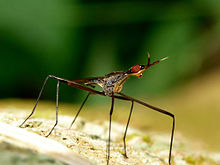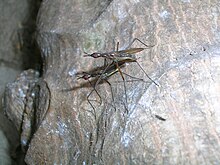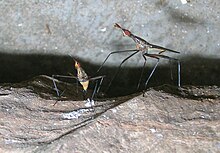Neriidae
| Neriidae | |
|---|---|

| |
| Telostylinus lineolatus from India | |
| Scientific classification | |
| Domain: | Eukaryota |
| Kingdom: | Animalia |
| Phylum: | Arthropoda |
| Class: | Insecta |
| Order: | Diptera |
| Section: | Schizophora |
| Subsection: | Acalyptratae |
| Superfamily: | Nerioidea |
| Family: | Neriidae Westwood, 1840 |
| Genera | |
| |
The Neriidae are a family of true flies (Diptera) closely related to the Micropezidae. Some species are known as cactus flies, while others have been called banana stalk flies and the family was earlier treated as subfamily of the Micropezidae which are often called stilt-legged flies. Neriids differ from micropezids in having no significant reduction of the fore legs. Neriids breed in rotting vegetation, such as decaying tree bark or rotting fruit. About 100 species are placed in 19 genera. Neriidae are found mainly in tropical regions, but two North American genera occur, each with one species, and one species of Telostylinus occurs in temperate regions of eastern Australia.
Family characteristics
Most species of Neriidae are slender, long-legged flies. Many exhibit striped patterns that appear to provide camouflage against tree bark. Many neriids are sexually dimorphic, with males having more elongated bodies, heads, antennae, and legs than females. In some species, the male fore-tibia is greatly thickened distally. Neriid flies are saprophagous. Larvae develop in rotting vegetable matter, including bark and fruit. Neriid adults tend to aggregate on rotting vegetable matter or damaged tree trunks. Neriid adults are also attracted to flowers or other sources of sugar. The upper face has a medial division and the antennae are porrect. The arista on the antenna arises at the tip (not dorsally, as in the Micropezidae). The fore legs are long with prominent coxae. In the Micropezidae, the fore legs are reduced. The fore femora (and sometimes all femora) bear ventral spines in males. The fore tibia of males may have rows of spines or tubercles. The third and fourth veins of the wing converge at the tip and the first vein is not setulose.[14] Neriids have 1-5 frontal bristles, no ocellar bristles and some have reduced postvertical bristles.
For terms see Morphology of Diptera
Ecology and evolution of neriid flies

Males of some species engage in spectacular combat for territory or access to females. The rivals elevate their bodies to an almost vertical posture, and pound each other with the ventral surfaces of their heads, strike each other with their forelegs, or try to place each other in a head-lock.[15] Photos of mating and combat can be seen here.
Research on the Australian neriid Derocephalus angusticollis has shown that adult body size and shape are extremely sensitive to larval diet: larvae reared in nutrient-rich substrates exhibit greater body size as adults, and males have more elongated bodies, compared to flies reared in nutrient-poor substrates.[16] The expression of male secondary sexual traits is particularly sensitive to the protein content of the larval diet.[17] Developmental plasticity in response to variation in larval diet quality has diversified among populations of Telostylinus angusticollis along the east coast of Australia.[18]
Research on Derocephalus angusticollis has also shown that a male's larval diet can influence the body size of his offspring. Males reared on a nutrient-rich larval diet produce larger offspring than their brothers reared on a nutrient-poor larval diet,[19] and this paternal effect appears to be sensitive to the male's social environment.[20] In addition, recent research on this species has led to the discovery of a new form of nonparental transgenerational effect, whereby a male's larval diet quality can influence the body size of offspring sired by a subsequent male that mates as much as two weeks later with the same female.[21] This effect is a form of telegony.

As in some tephritoid flies, neriid larvae in their final instar are capable of skipping. To skip, a maggot bends its body into a 'C', grasps its posterior end with its mouth-hooks, tightens the muscles in its body wall, and then releases its hold, causing its posterior end to recoil against the substrate. Although their skipping abilities are not as impressive as those of piophilid maggots, neriid maggots can skip distances > 20 cm.[citation needed]
References
- ^ Hennig, W. (1937). "Ubersicht über die Arten der Neriiden und über die Zoogeographie dieser Acalyptraten-Gruppe (Diptera)". Stettiner Entomologische Zeitung. 98: 240–280.
- ^ Hendel, Friedrich Georg (1903). "Ueber die systematische Stellung von Tanypeza Fall. (Dipt.)". Wiener entomologische Zeitung. 22 (201–205): 201–205. doi:10.5962/bhl.part.9739. Retrieved 30 May 2018.
- ^ a b c d e f g Enderlein, Günther (1922). "Klassifikation der Micropeziden". Archiv für Naturgeschichte. Abteilung A. 88 (4): 140–229. Retrieved 29 January 2021.
- ^ Aczél, M.L. (1961). "A revision of American Neriidae (Diptera, Acalyptratae)". Studia Entomologica. 4: 257–346.
- ^ Aczél, M.L. (1951). "Morfologia externa y division sistematica de las "Tanypezidiformes" con sinopsis de las especies argentinas de "Tylidae" ("Micropezidae") y "Neriidae" (Diptera)". Acta Zoologica Lilloana. 11: 482–589, 4 pls.
- ^ Hendel, Friedrich Georg (1913). "H. Sauter's Formosa-Ausbeute. Acalyptrate Musciden (Dipt.)". Entomologische Mitteilungen. 2: 65–70. doi:10.5962/bhl.part.14989. Retrieved 25 January 2022.
- ^ Koçak, A.O.; Kemal, M. (2009). "A replacement name in the family Neriidae (Diptera)". Misc. PPRS, Centre Ent. Stud., Ankara. 11–12: 147–148.
- ^ Wiedemann, Christian Rudolph Wilhelm (1830). Aussereuropäische Zweiflügelige Insekten. Vol. 2. Retrieved 21 April 2020.
- ^ Fabricius, Johann Christian (1805). Systema antliatorum secundum ordines, genera, species. Bransvigae: Apud Carolum Reichard. pp. i–xiv, 1–373. Retrieved 5 June 2020.
- ^ Cresson, E. T. Jr. (1926). "Descriptions of new genera and species of Diptera (Ephydridae and Micropezidae)". Transactions of the American Entomological Society. 52: 249–274.
- ^ Bigot, J.M.F. (1883). "[Description d'un nouveau genre et d'une nouvelle espèce de Diptères]". Bulletin Bimensuel de la Société Entomologique de France. 1883 (10): 89.
- ^ Meijere, J. C. H. de (1924). "Studien uber sudostasiatische Dipteren XV. Dritter Beitrag zur Kenntnis der sumatranischen Dipteren". Tijdschrift voor Entomologie. 67 (Suppl.): 1–64. Retrieved 10 October 2019.
- ^ Bigot, J.M.F. (1859). "Dipterorum aliquot nova genera". Revue et magasin de zoologie pure et appliquée. 11 (2): 305–315, pl. 11. Retrieved 26 February 2021.
- ^ McAlpine, David K. (1958). "A key to the Australian families of Acalptrate Diptera (Insecta)" (PDF). Records of the Australian Museum. 24 (12): 183–190. doi:10.3853/j.0067-1975.24.1958.650. Archived from the original on July 6, 2011.
{{cite journal}}: CS1 maint: unfit URL (link) - ^ Bonduriansky, R. (2006). "Convergent evolution of sexual shape dimorphism in Diptera". Journal of Morphology. 267 (5): 602–611. doi:10.1002/jmor.10426. PMID 16477603. S2CID 15548020.
- ^ Bonduriansky, R. (January 2007). "The evolution of condition dependent sexual dimorphism". The American Naturalist. 169 (1): 9–19. doi:10.1086/510214. PMID 17206580. S2CID 17439073.
- ^ Sentinella, A.T.; Crean, A.J.; Bonduriansky, R. (2013). "Dietary protein mediates a trade-off between larval survival and the development of male secondary sexual traits". Functional Ecology. 27 (5): 1134–1144. doi:10.1111/1365-2435.12104.
- ^ Cassidy, E.J.; Bath, E.; Chenoweth, S.F.; Bonduriansky, R. (2013). "Sex-specific patterns of morphological diversification: evolution of reaction norms and static allometries in neriid flies". Evolution. 68 (2): 368–383. doi:10.1111/evo.12276. PMID 24111624.
- ^ Bonduriansky, R.; Head, M. (2007). "Maternal and paternal condition effects on offspring phenotype in Telostylinus angusticollis (Diptera: Neriidae)". Journal of Evolutionary Biology. 20 (6): 2379–2388. doi:10.1111/j.1420-9101.2007.01419.x. PMID 17956399.
- ^ Adler, M.I.; Bonduriansky, R. (2013). "Paternal effects on offspring fitness reflect father's social environment". Evolutionary Biology. 40 (2): 288–292. doi:10.1007/s11692-012-9211-6. S2CID 255341774.
- ^ Crean, A.J.; Kopps, A.; Bonduriansky, R. (2014). "Revisiting telegony: Offspring inherit an acquired characteristic of their mother's previous mate". Ecology Letters. 17 (12): 1545–1552. doi:10.1111/ele.12373. PMC 4282758. PMID 25270393.
Further reading
- Phylogeny and identification
- Hennig, W. 1937. Übersicht über die Arten der Neriiden und über die Zoogeographie dieser Acalyptraten-Gruppe (Diptera). Stett. Entomol. Ztg. 98: 240–80. World genera, species and review.
- Aczel, M. L. 1954. Neriidae von Neuguinea (Diptera). Treubia 22:505-531.
- Aczel, M. L. (1959). "Diptera: Neriidae and Micropezidae (Tylidae)". Insects of Micronesia. 14: 47–90.
- Aczel, M. L. (1961). "A revision of American Neriidae (Diptera, Acalyptratae)". Studia Entomologica. 4: 257–346.
- Steyskal, G. C. 1987. Neriidae. pp. 769–771 in J. F. McAlpine, ed. Manual of Nearctic Diptera. Agriculture Canada, Ottawa, Ontario.
- Barraclough, D. A. (1993). "The southern African species of Neriidae (Diptera)". Annals of the Natal Museum. 34: 1–17.
- Sepúlveda, T.A.; Pereira-Colavite, A.; De Carvalho, C.J.B. (2013). "Revisión del género neotropical cerantichir (Diptera: Neriidae) con nuevos registros y clave de especies". Revista Colombiana de Entomologia. 39: 125–131.
- Sepúlveda, T.A.; Wolff, M.I.; De Carvalho, C.J.B. (2014). "Revision of the New World genus Glyphidops Enderlein (Diptera: Neriidae)". Zootaxa. 3785 (2): 139–174. doi:10.11646/zootaxa.3785.2.2. PMID 24872176.
- Mongiardino Koch, N.; Soto, I.M.; Ramirez, M.J. (2015). "First phylogenetic analysis of the family Neriidae (Diptera), with a study on the issue of scaling continuous characters". Cladistics. 31 (2): 142–165. doi:10.1111/cla.12084. hdl:11336/43113. PMID 34772260. S2CID 83566592.
- Early accounts
- de Meijere, J. C. H. (1908). "Studien uber sudostasiatische Dipteren II". Tijdschrift voor Entomologie. 51: 105–180.
- de Meijere, J. H. C. (1911). "Studien uber sudostasiatische Dipteren. VI". Tijdschrift voor Entomologie. 54: 258–432.
- de Meijere, J. H. C. (1924). "Studien uber sudostasiatische Dipteren. XV". Tijdschrift voor Entomologie. 67: 1–64.
- Berg, C.O. 1947. Biology and metamorphosis of some Solomon Islands Diptera. Part I: Micropezidae and Neriidae.Occas. Pap. Mus. Zool. Univ. Mich. 503, 14 p
- Steyskal, G. C. (1966). "Notes on flies captured in treetops in Malaya (Diptera: Empididae, Neriidae, Platystomatidae, Sepsidae, Muscidae)". Proceedings of the U.S. National Museum. 120 (3562): 1–16. doi:10.5479/si.00963801.120-3562.1.
- Life history and larval biology
- Olsen, L. E.; Ryckman, R. E. (1963). "Studies on Odontoloxozus longicornis (Diptera: Neriidae). Part I. Life history and descriptions of immature stages". Annals of the Entomological Society of America. 56 (4): 454–469. doi:10.1093/aesa/56.4.454.
- Ryckman, R. E.; Olsen, L. E. (1963). "Studies on Odontoloxozus longicornis (Diptera: Neriidae). Part II. Distribution and ecology". Annals of the Entomological Society of America. 56 (4): 470–472. doi:10.1093/aesa/56.4.470.
- Steyskal, G. C. (1965). "The third larval instar and puparium of Odontoloxozus longicornis (Coquillett) (Diptera, Neriidae)". Annals of the Entomological Society of America. 58: 936–937. doi:10.1093/aesa/58.6.936a.
- Behaviour
- Preston-Mafham, K (2001). "Resource defence mating system in two flies from Sulawesi: Gymnonerius fuscus Wiedemann and Telostylinus sp. near duplicatus Wiedemann (Diptera: Neriidae)". Journal of Natural History. 35: 149–156. doi:10.1080/002229301447916. S2CID 84988942.
- Eberhard, W. G. (1998). "Reproductive behavior of Glyphidops flavifrons and Nerius plurivitatus (Diptera: Neriidae)". Journal of the Kansas Entomological Society. 71: 89–107.
- Mangan, R. L. (1979). "Reproductive behavior of the cactus fly, Odontoloxozus longicornis, male territoriality and female guarding as adaptive strategies". Behavioral Ecology and Sociobiology. 4 (3): 265–278. doi:10.1007/bf00297647. S2CID 31593593.
- Wheeler, W. M. (1924). "Courtship of the Calobatas". Journal of Heredity. 15 (12): 485–495. doi:10.1093/oxfordjournals.jhered.a102407.
- Evolutionary ecology
- Runagall-McNaull, A.; Bonduriansky, R.; Crean, A. J. (2015). "Dietary protein and lifespan across the metamorphic boundary: protein-restricted larvae develop into short-lived adults". Scientific Reports. 5: 11783. doi:10.1038/srep11783. PMC 4484247. PMID 26119686.
- Nicovich, P.R.; Macartney, E.L.; Whan, R.M.; Crean, A.J. (2015). "Measuring sperm movement within the female reproductive tract using Fourier analysis". Microscopy and Microanalysis. 21 (1): 256–263. doi:10.1017/s1431927614014627. PMID 25640702. S2CID 17439461.
- Fricke, C.; Adler, M.I.; Brooks, R.C.; Bonduriansky, R. (2015). "The complexity of male reproductive success: effects of nutrition, morphology and experience". Behavioral Ecology. 26 (2): 617–624. doi:10.1093/beheco/aru240.
- Crean, A. J.; Kopps, A.; Bonduriansky, R. (2014). "Revisiting telegony: Offspring inherit an acquired characteristic of their mother's previous mate". Ecology Letters. 17 (12): 1545–1552. doi:10.1111/ele.12373. PMC 4282758. PMID 25270393.
- Cassidy, E.J.; Bath, E.; Chenoweth, S.F.; Bonduriansky, R. (2013). "Sex-specific patterns of morphological diversification: evolution of reaction norms and static allometries in neriid flies". Evolution. 68 (2): 368–383. doi:10.1111/evo.12276. PMID 24111624.
- Sentinella, A.T.; Crean, A.J.; Bonduriansky, R. (2013). "Dietary protein mediates a trade-off between larval survival and the development of male secondary sexual traits". Functional Ecology. 27 (5): 1134–1144. doi:10.1111/1365-2435.12104.
- Adler, M.I.; Bonduriansky, R. (2013). "Paternal effects on offspring fitness reflect father's social environment". Evolutionary Biology. 40 (2): 288–292. doi:10.1007/s11692-012-9211-6. S2CID 255341774.
- Adler, M.I.; Cassidy, E.J.; Fricke, C.; Bonduriansky, R. (2013). "The lifespan-reproduction trade-off under dietary restriction is sex-specific and context-dependent". Experimental Gerontology. 48 (6): 539–548. doi:10.1016/j.exger.2013.03.007. PMID 23542072. S2CID 6537772.
- Bath, E.; Tatarnic, N.; Bonduriansky, R. (2012). "Asymmetric reproductive isolation and interference in neriid flies: the roles of genital morphology and behaviour". Animal Behaviour. 84 (6): 1331–1339. doi:10.1016/j.anbehav.2012.08.025. S2CID 53191020.
- Kopps, A.M.; Bonduriansky, R.; Gilchrist, A.S.; Crean, A.J. (2012). "Isolation and characterization of polymorphic microsatellite loci for the neriid fly Telostylinus angusticollis using MiSeq sequencing". Australian Journal of Zoology. 60 (6): 388–391. doi:10.1071/zo13017. S2CID 16503451.
- Adler, M.; Bonduriansky, R. (2011). "The dissimilar costs of love and war: Age-specific mortality as a function of the operational sex ratio". Journal of Evolutionary Biology. 24 (6): 1169–1177. doi:10.1111/j.1420-9101.2011.02250.x. PMID 21375650.
- Bonduriansky, R (2009). "Condition dependence of developmental stability in the sexually dimorphic fly Telostylinus angusticollis (Diptera: Neriidae)". Journal of Evolutionary Biology. 22 (4): 861–872. doi:10.1111/j.1420-9101.2009.01686.x. PMID 19220651.
- Kawasaki, N.; Brassil, C.E.; Brooks, R.; Bonduriansky, R. (2008). "Environmental effects on the expression of lifespan and aging: An extreme contrast between wild and captive cohorts of Telostylinus angusticollis (Diptera: Neriidae)". The American Naturalist. 172 (3): 346–357. doi:10.1086/589519. PMID 18710341. S2CID 14750605.
- Bonduriansky, R.; Head, M. (2007). "Maternal and paternal condition effects on offspring phenotype in Telostylinus angusticollis (Diptera: Neriidae)". Journal of Evolutionary Biology. 20 (6): 2379–2388. doi:10.1111/j.1420-9101.2007.01419.x. PMID 17956399.
- Bonduriansky, R (2007). "The evolution of condition dependent sexual dimorphism". The American Naturalist. 169 (1): 9–19. doi:10.1086/510214. PMID 17206580. S2CID 17439073.
- Bonduriansky, R (2006). "Convergent evolution of sexual shape dimorphism in Diptera". Journal of Morphology. 267 (5): 602–611. doi:10.1002/jmor.10426. PMID 16477603. S2CID 15548020.
External links
- Family Neriidae at EOL
- Diptera.info
- Images (in Japanese)
- Behaviour
- Bug Guide
